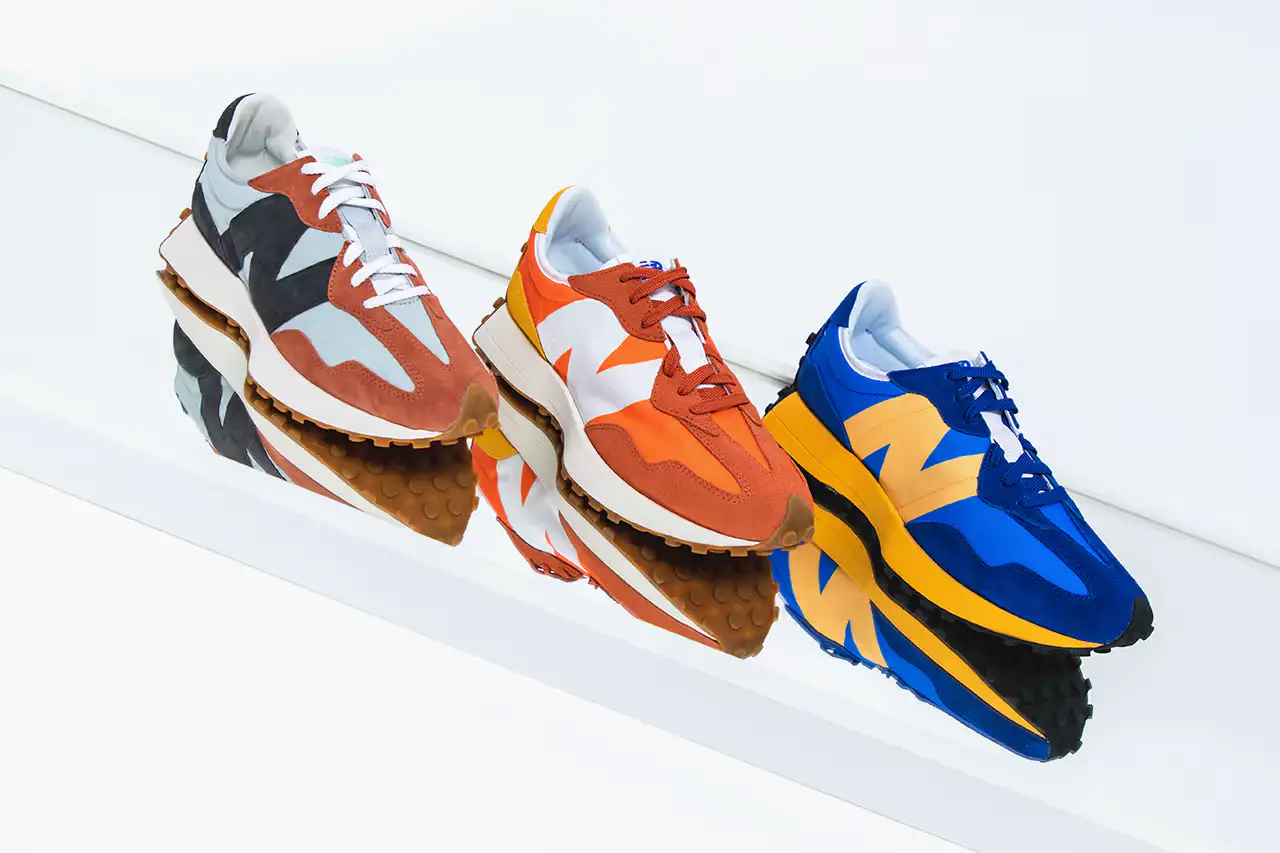What the world’s most unlikely sneaker icon can teach us about timeless brand psychology. The story of New Balance is about how to build relevance in a noisy world, by staying true to what works, letting craft speak louder than campaigns, and proving that patience can still be a competitive advantage. This essay is for those who live at the intersection of branding, design, and entrepreneurship, people who want to understand how authenticity scales, and why the quietest brands often end up leading culture.
For decades, New Balance stood for comfort and practicality. It had no street cred. Grey suede and mesh sneakers were a uniform of function, worn by tech founders, suburban dads, and athletes who valued purpose over polish.
It was Steve Jobs’ shoe of choice, and Ryan Gosling’s punchline in the 2011 movie Crazy, Stupid, Love. The same sneakers once mocked for their plainness are now a global symbol of taste.

New Balance didn’t become cool by chasing cool. It didn’t pivot, pander, or tried to mimic Gen Z. The culture simply caught up to what New Balance had always been: quiet craftsmanship, patient confidence, and design that refuses to age.
Refusing to Fix What Wasn’t Broken
New Balance was never built for fashion. It began in 1906, making arch supports for people who spent long hours on their feet. That focus on comfort and performance, not presentation, quietly became its defining trait.

How the 990 Redefined Everyday Luxury
In 1982, the brand introduced the 990, a high-performance running shoe that quickly became a statement of quality and a badge of understated taste. Priced at an audacious $100 (about $336 today), it was the first sneaker to cross the psychological barrier of luxury pricing in sportswear. Every pair was made in the United States, every stitch serving function before form.

All this happened three years before sneaker culture’s golden child, the Air Jordan 1, debuted at $65.
More than four decades later, models like the 990v6 still retail above $200, many still crafted in domestic factories. The “Made in USA” line has become more than a hallmark, producing some of its highest-quality offerings.
Its early tagline said it best: Some mistook it for irony, but it was simply truth disguised as marketing. The 990 taught New Balance something few brands ever learn: refinement compounds faster than reinvention, and design that stays honest never goes out of style.
When Controversy Tested Character
Just as New Balance was earning quiet respect in the fashion world, it found itself in a political storm. In 2016, Matt LeBretton, the brand’s vice president of public affairs, spoke out against the Trans-Pacific Partnership, a sweeping trade deal championed by the Obama administration to make imports cheaper and expand U.S. trade across the Pacific Rim.
The TPP Moment and Brand Integrity
For most global brands, that sounded like progress. But for New Balance, which still manufactured millions of shoes in the United States, the TPP posed an existential threat. Cheaper imports would erode its Made in USA promise, the cornerstone of its identity. While Nike supported the deal, New Balance opposed it to defend domestic manufacturing.
The timing couldn’t have been worse. Donald Trump was campaigning against the same trade pact. Within hours, the brand’s economic stance was mistaken for political support.
The nuance vanished; headlines didn’t. Customers boycotted. Videos of burning New Balance sneakers went viral. When reports surfaced that owner Jim Davis had donated to Trump’s campaign, far-right groups tried to claim the brand as their own.
New Balance didn’t fight outrage with outrage. It clarified its position, reaffirmed its manufacturing roots, and returned to what it knew best, building shoes worth talking about.
By 2024, New Balance recorded its best year yet: $7.8 billion in global sales, up 20 percent from the year before. Nike still led at $51 billion and Adidas at $23 billion, but the momentum had shifted. Google Trends showed the brand reaching its highest search traffic in five years, and even internal Nike presentations leaked in 2021 expressed concern about losing customers to smaller, steadier brands like New Balance, brands that didn’t turn loyalty into a waiting room.
The controversy that could have ended New Balance became proof of what sustained it: conviction, craftsmanship, and the patience to let trust do the talking.
Collaborations That Tell Stories
The 2010s were a decade of noise. Sneakers screamed for attention, Yeezys, Off-Whites, Balenciagas that looked engineered for virality. Drops sold out in seconds; resale prices doubled overnight. Brands were selling scarcity more than shoes.
New Balance went the other way. In an era addicted to attention, hype and spectacle, it leaned into something rarer: quiet confidence.
Collaboration has always been the pulse of sneaker culture. Nike built an empire on the back of the Air Jordan 1, launched in 1985 with Michael Jordan’s rookie energy and rebellious spirit. It redefined what a shoe could represent: status, aspiration, rebellion, and turned sneakers into collectibles. Adidas globalized that formula, teaming with Run-D.M.C., Pharrell, and later Kanye West. At its peak, Yeezy generated over $2 billion a year, nearly 8 percent of Adidas’ total revenue, before their eventual split in 2022.
How Aimé Leon Dore Resurrected the 550
New Balance studied that playbook and chose a different tempo. Its collaborations avoided pyrotechnics or celebrity entourages, instead feeling like conversations between craftsmen.
The Aimé Leon Dore x 550 (2020) resurrected a forgotten ‘80s basketball silhouette and made it modern gospel. Without any hashtags or gimmicks, it just sold good design and good timing. Joe Freshgoods’ “Conversations Amongst Us” (2021) and “Inside Voices” (2022) used sneakers to talk about culture and community. Salehe Bembury’s 990v3 (2022) brought texture and warmth to dadcore, placing New Balance beside Comme des Garçons and Sacai on boutique shelves in Tokyo.

Each release proved the same quiet thesis: in a world that shouts, subtlety stands out.
By 2022, names like Justin Bieber, Zoë Kravitz, and Gigi Hadid were wearing what was once mocked as “dad shoes.” From ALD to Staud to Miu Miu, nearly every partnership since 2018 has struck gold. The Miu Miu x New Balance 574, handcrafted in Italy and retailing at $700 for a model that usually costs $85, turned a utilitarian sneaker into a statement of modern luxury.

New Balance didn’t collaborate to borrow cool, but to translate integrity. Each partnership told the same story in a new accent: proof that restraint, when done right, can be contagious.
Teddy Santis and the Rebranding of American Luxury
When New Balance appointed Teddy Santis founder of Aimé Leon Dore, as creative director of its Made in USA line in 2021, it was, in essence, making a statement: that American craftsmanship could be luxury again.

Aimé Leon Dore had already built a quiet empire from nostalgia. The New York label mixed Queens streetwear with European tailoring, vintage palettes, and cinematic storytelling. Its world felt both familiar and aspirational, like memory rendered in color.
What ALD’s Aesthetic Taught New Balance
Santis brought that same sensibility and warmth to New Balance. Under his direction, luxury became emotional, familiar, and real. Earth tones, cream midsoles, retro sportswear cues, and tactile materials replaced noise with nuance. The Made in USA program evolved into a study in refinement, sneakers that looked effortless but felt deliberate, casual yet composed.
He moved the brand away from logo-driven identity and toward sensory experience, the kind of richness you feel, not flaunt. In doing so, Santis reframed what American luxury could mean: quietly crafted, proudly domestic, timeless in its restraint.
Every drop under his direction, from the 990v3 in Moonbeam to the 996 in Rich Earth, felt collectible without chasing hype. Each release proved that confidence doesn’t need volume; it just needs consistency.
Even in resale markets, pairs from the 550, 990, and Salehe Bembury lines began trading for two or three times their retail price, a space once dominated by Nike and Yeezy. What started as cultural credibility evolved into tangible economic value.

Design That Ages Well
Some brands build their reputation on reinvention. New Balance built its on refinement. The beauty of its design language lies in how little it tries to impress you.
New Balance’s resurgence rests on a quiet understanding of design and longevity. Instead of chasing novelty, the brand built its foundation on silhouettes that had already earned decades of trust. Each pair feels familiar yet considered, refined just enough to belong to the present without losing its roots.
Why Refinement Beats Reinvention
The carries the DNA of 1970s running culture: light, asymmetric, and quietly confident. It feels archival without feeling old. The 550, once a forgotten basketball relic, found a second life not through exaggeration but through proportion. It fits effortlessly into today’s wardrobes because it never belonged to a single moment in time. And the 990, still the crown jewel, evolves in increments, each version an evolution you can trace, not a reset.

Materials are where New Balance tells its story best: suede soft enough to live in, mesh that breathes but holds shape, midsoles with just the right yellowing to suggest age without decay. These choices give each pair personality. They endure through the rhythms of real life and gather stories along the way.
Owning a pair of 990s or 550s says something unspoken, that you value design you can actually live with. In a landscape ruled by hype cycles and limited drops, this restraint feels like the real luxury.
Because in design, as in life, timelessness isn’t built by chasing change. It’s built by earning belonging.
New Balance’s Marketing Minimalism and Global Resonance
New Balance’s rise has been quiet but deliberate, the result of consistency that prefers showing over telling. Its marketing mirrors its design philosophy: measured, human, and rooted in clarity.
The 2018 campaign “Fearlessly Independent Since 1906” set the tone. It positioned New Balance not as a brand comfortable in its own skin. Drawing from its manufacturing heritage, it celebrated craft and community over celebrity. Independence became less about rebellion and more about direction: knowing who you are and staying there.
Two years later, “We Got Now” carried that energy forward. Featuring athletes like Coco Gauff, Sydney McLaughlin-Levrone, and Shohei Ohtani, all known for rewriting success on their own terms, the campaign emphasized presence and purposeful, over perfection. It avoided the exaggeration of most sports advertising, focusing instead on the grounded rhythm of real ambition.
This quiet honesty found an audience across cultures. In Tokyo and Seoul, the brand’s muted palettes and material precision reflected local appreciation for detail. In London and Amsterdam, where style is understated, New Balance slipped naturally into the rhythm of everyday wardrobes. The sneakers became part of the rhythm of urban life instead of a statement against it.
Every campaign and collaboration has reinforced the same foundation: consistency, when executed with care, creates trust. New Balance never needed to reinvent its story. It only needed to keep telling it clearly.
Post-Pandemic Consumer Psychology
When the world slowed down, so did its appetite for noise. The uncertainty of the pandemic made authenticity urgent and spectacle exhausting. A PubMed study found that under the threat of COVID-19, consumers showed a significantly stronger preference for products advertised with genuine, transparent messages.
This shift went far beyond sneakers. Across fashion, luxury houses traded loud logos for quiet craftsmanship. The Succession-era aesthetic of “stealth wealth”, neutral palettes, tailored fits, minimal branding, became the global mood board. A Business of Fashion and McKinsey report called it a move toward “discreet expression,” where cultural capital came from connoisseurship or carefully curated style.
New Balance didn’t have to chase that trend; it had been living it all along. What the world began to crave after 2020 was what the brand had quietly practiced for decades. Its devotion to function, muted tones, and enduring materials suddenly felt prophetic.
In a culture learning to value calm over constant change, New Balance became shorthand for a new kind of taste: design maturity.
What Comes Next for New Balance
New Balance now stands at a crossroads few brands reach: culturally credible, commercially strong, and still unmistakably itself. Its next challenge is to protect that balance as it grows.
As competitors accelerate into digital futures, Nike investing in virtual sneakers through RTFKT, Adidas experimenting with AI-assisted design, New Balance moves slower by choice. Its strength still lies in the tangible: the feel of suede, the weight of craftsmanship, the way a product fits into real life. The question ahead is whether that emotional connection can translate into a world increasingly shaped by algorithms and virtual identity.
Can Patience Scale in the AI Era?
Early signs say it can. The brand has quietly integrated data-driven production to improve comfort and fit, while continuing to lead with storytelling, collaboration, and human craft. Partnerships with creative directors like Teddy Santis and designers such as Salehe Bembury prove that evolution doesn’t always require acceleration. Sometimes, it just needs intention.
The next decade will test whether restraint can scale. Consumers today value longevity and repairability over relentless novelty. A 2024 Deloitte study found that 68% of Gen Z buyers prefer brands that build products to last.

If New Balance continues to listen closely, to its makers, designers, and wearers, it may stay relevant for the same reason it became beloved: because it never mistook speed for progress.
A century after its founding, New Balance’s story feels more modern than ever, a reminder that the future often belongs to those who refuse to rush.
Endurance Is Its Own Innovation
New Balance’s story began with arch supports, not aesthetics. For over a century, it stood quietly for balance, between performance and patience, craft and culture. The world eventually caught up. In an era obsessed with disruption, New Balance became a reminder that endurance is its own kind of innovation. It didn’t win the race by running faster, but by never changing its stride.
TL;DR: The Quiet Comeback of New Balance
- Core Idea: New Balance’s rise wasn’t built on hype, but on patience. It shows how staying true to what works can outlast entire waves of culture.
- What It Teaches: 1. Refinement compounds faster than reinvention. 2. Authenticity scales when it’s consistent. 3. Quiet confidence builds louder trust than spectacle.
- Why It Matters: In a world that rewards noise, New Balance proved that endurance, restraint, and craft can still lead the culture forward.



